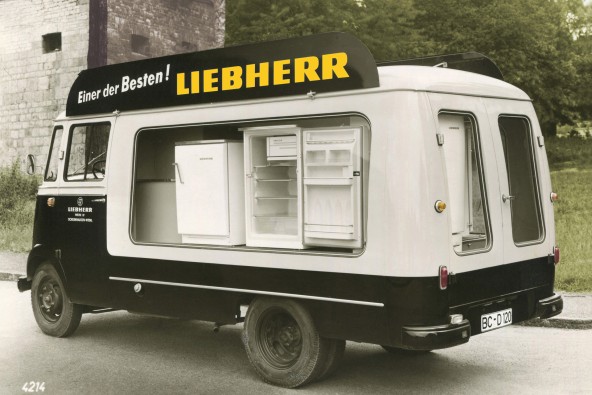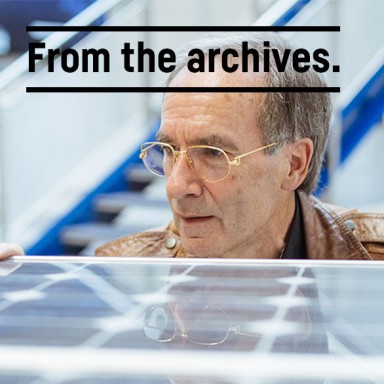
The art of shaping the future from the past
The first Liebherr refrigerator rolled off the production line 70 years ago. In accomplishing this, Hans Liebherr not only opened up a new business area, but once again demonstrated his infallible instinct for identifying promising markets. His courage to break new ground is still deeply rooted in the company today. Liebherr has reopened a chapter in their history to mark this anniversary.
Recognising the signs of the times
Putting the right idea into practice at the right time, pursuing goals with unwavering determination and a solid instinct for recognising promising sectors were among the secrets of Hans Liebherr’s success. These laid the foundations for a large number of pioneering inventions, starting with the world’s first mobile tower crane, which marked the birth of the company in 1949 and accelerated the rebuilding of war-torn Germany. Occasionally, however, it was personal contacts that gave Hans Liebherr the drive to pursue new areas of business. In 1953, the manager of his local bank told him about a refrigerator factory that was up for sale due to bankruptcy. While the product had been seen as an everyday kitchen appliance in the USA from the 1930s onwards, it was still considered a luxury item in Germany for quite some time. It was expensive, bulky and dependent on a reliable power supply – only one in ten households had their own refrigerator. However, in the 1950s, the economic upturn gave the company the financial tailwind it needed: while the cost of living stagnated, purchasing power rose and increasing prosperity set the standard for a new quality of life. Holidays, cars, furniture and electrical appliances became affordable consumer goods.
A cool head for business
After a thorough analysis, Hans Liebherr immediately recognised the potential to close the considerable gap in the market for domestic refrigerators. He already knew from past experience that the ability to spot market needs and trends is crucial for success. Nevertheless, Hans Liebherr refused to buy the factory and instead set up his own production site in Ochsenhausen in southern Germany – a long-term investment in the future. This enabled him to control the manufacturing process and the quality of the products from the outset, respond quickly to changes in the market and to develop and implement innovative technologies himself. In 1954, the first refrigerators rolled off the production line in Ochsenhausen.
In the years that followed, refrigerators became increasingly common in private households, significantly improving the quality of life of their owners. The revolutionary appliance not only changed shopping habits, but also the entire food culture, with the nation’s diet becoming more varied and healthier as a result. This new world of possibilities made owning your own refrigerator an attractive prospect and turned it into a symbol of prosperity and progressiveness. Hans Liebherr’s decision to focus on in-house development and production soon bore fruit: in 1958, just three years after the start of series production, the 100,000th refrigerator left the plant in Ochsenhausen.
The beginning of a new era
The 1960s heralded an era of dynamic transformation. While legendary pop bands shaped generations, the baby boom reached its peak and the world of fashion experimented with vibrant colours and psychedelic patterns, the decade also produced a whole series of major technical advancements. In the early sixties, the economic miracle continued and this heyday of consumer culture also heralded a revolutionary phase for advertising, which often reflected the zeitgeist and progress of society. The advertising industry became more creative, bolder and more diverse: colourful, high-contrast designs, iconic campaigns and pithy slogans set new standards.
Until the early 1960s, around half of German households had a refrigerator – the remaining 50 % meant room for improvement for Hans Liebherr’s business, which had also been producing freezers since 1961. Increasing competition made it necessary to stand out from the company’s rivals and strengthen the brand. To boost sales, Liebherr came up with an ingenious marketing strategy: from now on, the wheels of advertising would be set in motion. Literally.

Moving with the times: a van conquers the Federal Republic of Germany
Liebherr went to great lengths to transform various vehicles into ‘shop windows on wheels’, including the L 319 van from Mercedes-Benz. With its compact dimensions, robust engineering and high payload, the series, produced from 1955 to 1968, was tailored to perfectly meet the needs of the years of the economic miracle and was ideal for use in trade, crafts and industry. Touted by Mercedes-Benz itself as a ‘motorised advertising medium’ with ‘exceptionally generous advertising space’, the L 319 seemed virtually predestined for Liebherr’s plan.
For years, the van showcased the latest refrigerators and freezers all across Germany, perfectly staged thanks to special platforms on the loading area. Large windows were installed on the sides and rear of the converted vehicle to provide the best possible view of the models. Sales partners were able to hire the L 319 and its sister vehicles from the sales department in Ochsenhausen in order to present the latest products to their customers directly on site. This innovative marketing strategy offered customers a unique experience, allowing them to take a closer look at the products and be won over by their quality. Liebherr had its finger on the pulse of the times – the concept struck a chord and increased Liebherr’s brand presence through the attention it received. The combination of the striking Mercedes-Benz design and the special adaptations for Liebherr made the L 319 a real eye-catcher out on the road. Touring around as a mobile shop window, the vehicle raised the profile of Liebherr as a manufacturer of refrigerators and freezers, with the company gaining brand enthusiasts throughout the country. Even after it reached the end of its service life, the L 319 has remained a cult classic for Liebherr. For employees in the refrigerators and freezers product segment, it stands as a proud symbol of their history.

Breathing new life into old ideas
More than five decades after the L 319 made its final tour, Liebherr breathed new life into the tradition of the shop window on wheels. ‘Think big’ was the motto, as the van from the 1960s made way for a superlative Mercedes-Benz truck – 17 metres long and weighing almost 35 tonnes, and offering an impressive 65 square metres of display space thanks to its extendable side panels. In February 2023, the truck set off from Ochsenhausen for the first time on a 99-day roadshow through 36 cities in Austria, Slovenia, Hungary, the Czech Republic, Slovakia and Poland, primarily to facilitate direct dialogue with specialist retailers. The mobile showroom travelled 7,400 kilometres on its journey and, within the truck itself, presented 17 innovative refrigerators and freezers for domestic and commercial use.
The idea of taking new products directly to customers so they can be wowed by the goods up close is as well received today as it was back then. So well, in fact, that it was played out two more times in 2024: the ‘Road to Freshness’ journeyed once through the vibrant cities of France and another time through the picturesque landscapes of Switzerland. The truck visited a total of 30 cities on its two tours.
Back to its roots: the return of an icon
With its mobile showroom, Liebherr has transported a successful model from the 1960s into the present day, and created the perfect interplay of tradition and innovation. The company’s success story also shows how closely the past and future are entwined. The milestone anniversaries – 75 years of Liebherr and 70 years of refrigerators and freezers – provide an ideal opportunity to look back at our roots – and inspire us to continue to face change with the necessary entrepreneurial foresight and be of one mind with Hans Liebherr as we carry on his legacy: his pioneering spirit still characterises the Group today and inspires employees around the world to be passionate about putting their ideas into practice. And to mark the anniversary, Liebherr has put one very special idea of its own into practice: a faithful replica of the historic L 319, which revives a piece of history and pays homage to the iconic vehicle.
The complex project was carried out by Werner Dreyer Kfz GmbH in Alfeld (Germany), a Mercedes-Benz workshop with five decades of experience that has specialised in the restoration of classic trucks since 1994. The highly qualified Dreyer team devoted months of their time to overhauling a veteran L 319 truck, assembling, welding and painting it, repairing, replacing or rebuilding individual parts, overhauling the mechanics and retrofitting the electrics. For the first time, a cabinetmaker specialising in the restoration of antiques also joined the team, taking care of everything from the frames of the new window cut-outs to the entire interior and the faithfully reproduced door seals of the refrigerators and freezers. Countless hours of work went into the replica, until the L 319 was unveiled in splendour, rising like a phoenix from the ashes, and was presented for the first time at the 100th edition of the IFA (consumer and electronics show) in Berlin (Germany) in September 2024.
Michael Kunz, manager global indirect material at Liebherr-Hausgeräte Ochsenhausen GmbH (Germany), also put his heart and soul into the project. A Liebherr tabletop refrigerator – a gift from his mother-in-law – ignited his passion for collecting Liebherr memorabilia and historic refrigeration appliances many years ago. Over time, his collection has grown – as has his fascination with the L 319. He had long harboured the desire to get the masterpiece back on the road. Speaking in an interview, Michael Kunz explains how his wish came true and provides exciting insights into the replica.
Interview with Michael Kunz
Manager global indirect material at Liebherr-Hausgeräte Ochsenhausen GmbH (Germany)Michael Kunz, manager global indirect material at Liebherr-Hausgeräte Ochsenhausen GmbH (Germany), also put his heart and soul into the project. A Liebherr tabletop refrigerator – a gift from his mother-in-law – ignited his passion for collecting Liebherr memorabilia and historic refrigeration appliances many years ago. Over time, his collection has grown – as has his fascination with the L 319. He had long harboured the desire to get the masterpiece back on the road. Speaking in an interview, Michael Kunz explains how his wish came true and provides exciting insights into the replica.
Cool facts and figures
In the first year of series production, Liebherr manufactured a total of 4,495 refrigeration appliances. By 1960, the production process in Ochsenhausen was so sophisticated that a ready-to-ship refrigerator could roll off the production line and be prepared for dispatch every 40 seconds. Today, Liebherr operates a total of five production sites in Europe and Asia and has manufactured more than 77,000,000 refrigerators and freezers by 2023.
In autumn 2019, former Liebherr employee Josef Niedermaier made a lucky find with the KT115/88 refrigerator. Niedermaier bought the old appliance from a clearance centre for €20 and tested it at home. Once connected to the power supply, the compressor soon began to hum steadily, the light switched on and it started to cool. Niedermaier was able to clarify exactly how old the appliance really is with a former Liebherr refrigerant specialist. He identified F12 refrigerant in the refrigerator, which was only used in production in Ochsenhausen for a very short period. The refrigerator dates back to 1955, making it the oldest Liebherr refrigeration appliance – and still fully functional after all these years.
In 1950, the Federal Republic of Germany – still in its infancy – was in a precarious situation, but at the same time the year marked the start of the economic upswing that later brought about full employment and prosperity. Within a decade, the average gross annual salary almost doubled and in 1962 was the equivalent of around 7,400 Deutsche Marks1. To put this into perspective, a large KS 212 fridge-freezer combination from the 1962 Liebherr refrigerator programme cost around DM 650, with the vegetable trays costing an additional DM 30. This is a good example of why refrigerators – and indeed many other household goods – were long considered a luxury and only became affordable for the majority of the population as purchasing power increased. As an aside, the KS 212 was one of the display items carried by the L 319 as it travelled around the country in the 1960s.
After a while, the shop window on wheels gained a little brother: back in 2006, collectors as well as fans of Liebherr and all things retro were able to purchase the iconic L 319 in 1:43 scale in the Liebherr shop, and the popular model is available in the shop once again in 2024 to mark the anniversary. While the original 1960s vehicle boasted black paintwork and a yellow logo, this model is available in a rich blue – the primary brand colour of the refrigerators and freezers product segment since the 1970s.
German engineer and scientist Carl von Linde laid the foundations for modern refrigeration appliances with his pioneering work in the field of refrigeration technology and gas liquefaction. He developed a refrigeration machine that could produce artificial ice using ammonia, making it possible to brew beer even in summer. For six years, the pioneer tinkered and repeatedly made improvements to his prototypes until the first refrigeration machine was delivered to the Dreher brewery in Trieste (Italy) in 1877 and, after further design optimisations, became a bestseller in the industry in Europe. Ultimately, von Linde revolutionised the entire food industry with his innovative refrigeration technology and his work was also influential and indispensable for other industries and production processes; in the field of gas liquefaction, for example, it played its part in the development of cryogenics.



